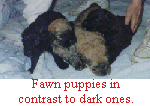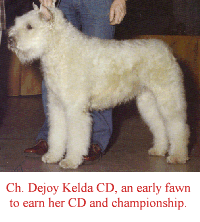The fawn coated Bouvier is an intrinsic color to the breed and was the predominate color of the Bouviers of the early 1900s as chronicled by this photo taken at the 1912 Brussels show. Of the nine Bouviers depicted in the photo, five of them are distinctly light in color, one is black and two are light silver.

At the St. Hubert Club of the North of France, at the fourth international show held at Roubais in 1905, there were 43 dogs entered and 10 dogs in the Open class Of the ten in Open, they were described as; brindle, white on chest; russet fawn; black, white chest; light gray; steel gray; gray brindle; brindle; fawn; steel gray, white chest. Of the ten shown, of particular interest are the russet fawn, and the "fawn" - showing a delineation of color much as light gray, steel gray, gray brindle and brindle are described. The dictionary describes "russet" as reddish brown.
Since the light color of the Bouvier has occurred continuously throughout its breeding history, one wonders why at different times has the lightest of the coat, called fawn, blonde, white or pale yellow, tiger brindle or wheaten, been popularized and at other times been maligned and ostracized.
The early imports of Chastel and Grulois (de Ia Thudinie and Du Posty Arloquin) were by that time predominately dark brindle and light brindle. The early breeders found that the darker colors were preferred in Europe and began to associate genetic problems with the lighter coats, not so much because it was so, but because several light color dogs had skin, coat, and eye problems. They found that the darker coated dogs were hardier and more valuable for their working characteristics and temperaments. They were also more plentiful as the light coat was genetically recessive and seen less in the litters. The occasional light puppy was either culled or given away as a pet. Early breeders did not approve of the light colors for fear of it being a stepping-stone towards albinism.
 It
is difficult to know for sure, but it appears that there is no history
of a fawn Bouvier being imported into the United States from France, Belgium,
or Holland. Most fawns from litters born there are still sold as
pets, or culled, or disposed of quickly.
It
is difficult to know for sure, but it appears that there is no history
of a fawn Bouvier being imported into the United States from France, Belgium,
or Holland. Most fawns from litters born there are still sold as
pets, or culled, or disposed of quickly.
In 1971, the first fawn in America finished its championship. Ch. Bibarcy Songeuse, a bitch, owned and bred by Art and Mary Pedersen, earned her title. The first fawn male, Ch. Madrone Ledge Valmur bred by Marion and Ray Hubbard and owned by Pat and Bert Ennis, finished in 1973. Ch. Lillies Veette, a bitch, owned by Wallace Lumpkin, finished in 1974. The first fawn to pioneer in obedience and was also a champion, was Madrone Ledge Vanilla CD, who was a champion in 1974 and got his CD in 1977. Other early fawns were Ch. Dejoy's Kelda CD, who finished in 1979 and was obedience titled in 1978. Ch. Timlor Brandywyne bred by Loryce Heisel and owned by Alan and Marily Baruch, also finished in 1979. One of the most famous fawns at that time was Ch. Pouky Jones who was the first fawn to earn her CDX and did so in 1975. in 1976, this fawn, bred and owned by Elsie Guseila, was the first to place in the Top Ten Bouviers nationwide for breed wins. A California Bouvier, Ch. Steadfast Recaro, was one of the first fawn Bouviers to be specialed and went Best of Breed in 1979 at the Panhandle Kennel Club show, but was unable to place in the Groups. Brandywyne, Kelda, and Recaro were sired by Ch. Deewal Victor, who was a producer of fawns during his reign as a top stud dog and his get also threw the light color. Many of the light-colored Bouviers today can trace back to him.

After 1970, two to three fawns a year earned their championship. However, winning the Breed and/or placing in the Groups was another thing. As fawns became more popular during the 1980's, several made an impact in the Group ring The first fawn to earn a Group One was owned by the Lubke's and was Ch. Olympus Raja, bred by George Kroeson. Another fawn bitch, Donwood's Ambiance Buffy, graced the cover of Dog World, and gave instant recognition to the fawn nationwide. The first fawn to go Best in Show was a bitch, Ch. Galbraith's Eye Spy, who went on to promote the fawn extensively and became the top-winning Bouvier bitch in the history of the breed. Bred by Joan and Dave Galbraith and owned by Bo Blanton and Jay Van Dwingelen, Eye Spy or "Ginny" as she was called, was pioneered to her victories by Ken and Ellie Rensink.
With the gradual popularity of the fawn, came the critics, and the critics are still among us as to the definition of the color. The light-colored Bouvier is accepted for the most part, but it is the actual pigmentation and presentation to the fancy that is argued. For the most part falls, the argument falls into two categories: too light and TWO colored. Where does one draw the line on too light - verging on pure white? And where does one draw the line on two-toned light colors? On the legs and neck, and a darker saddle on the body area? Many light gray brindle Bouviers with lighter legs have finished and are seen occasionally. These are not desirable to the studious breeder just as the lightest of the fawns is not desirable to the studious breeder. The Standard Committee of the American Bouvier des Flandres Club has made a clear and concise description of "fawn" in Dirty Beards, Fall issue 1997.
It will be up to the judges and the breeders to decide where to draw the line and how severely to penalize a light dog just as they may have faulted one that is above or below the medium of the standard for height, or for eye color, or for coat texture, or for movement. Although good dogs and bad dogs may finish their championships, a championship means nothing, unless it is combined with a gene pool for the betterment of the breed, to produce Bouviers whose overall quality is better than its predecessors.
"No good dog can be a bad color," has been attributed to Justin Chastel,
yet he insisted that the darker colors were preferred. It is more important
than ever for the breeder to keep the total dog in mind and breed for a
pure type and soundness above all else. The coat color is a consideration
in breeding and pigmentation must be foremost as well as correct texture.
As the fawn becomes more and more popular, it is important to seek out
the very best overall dog and insist that there be enough pigmentation
to keep it true to the standard.